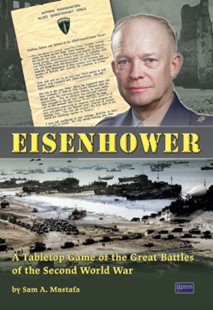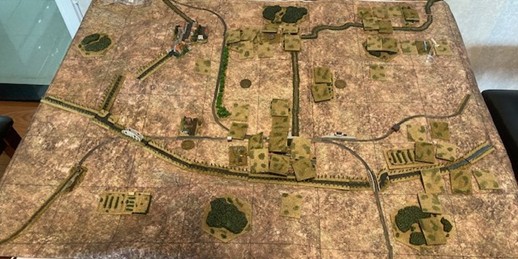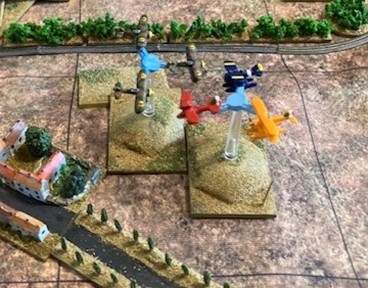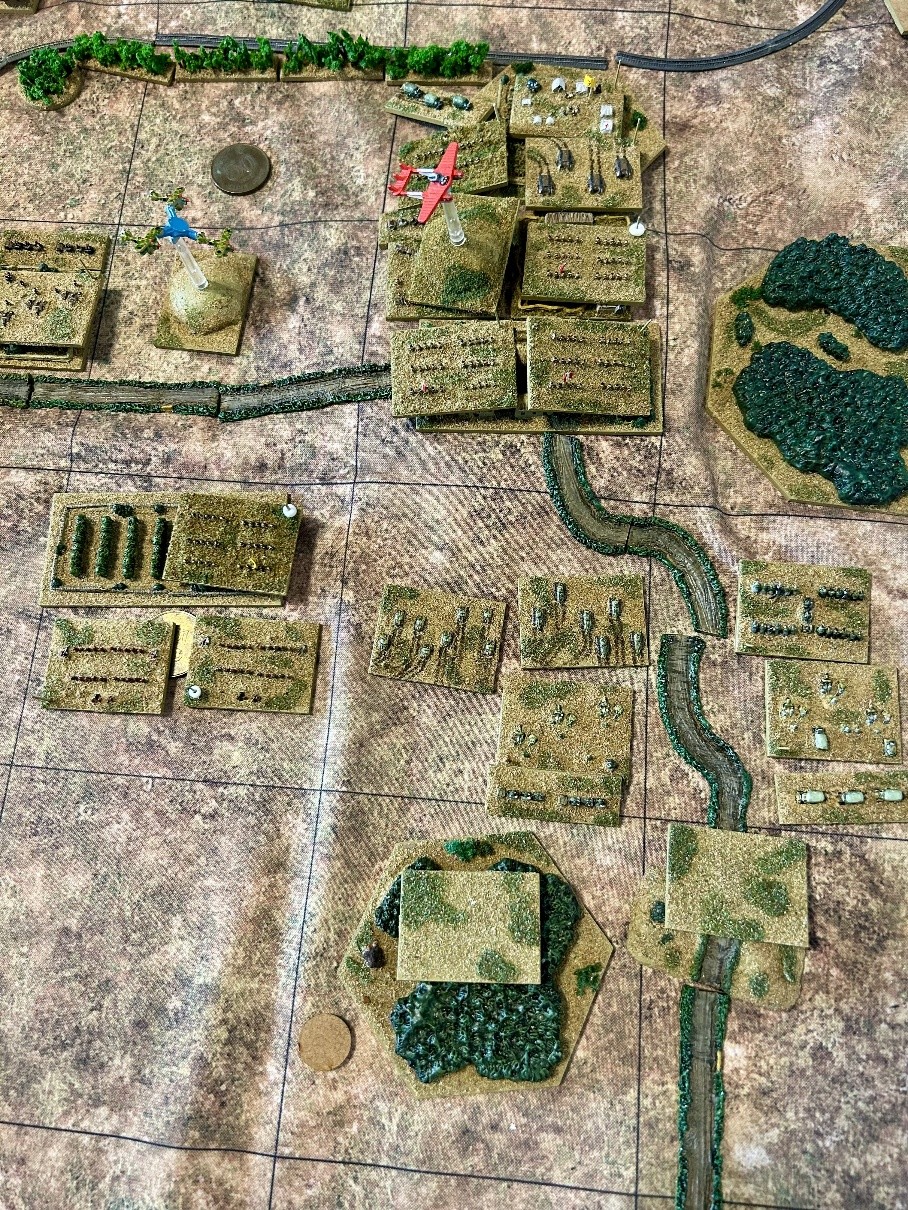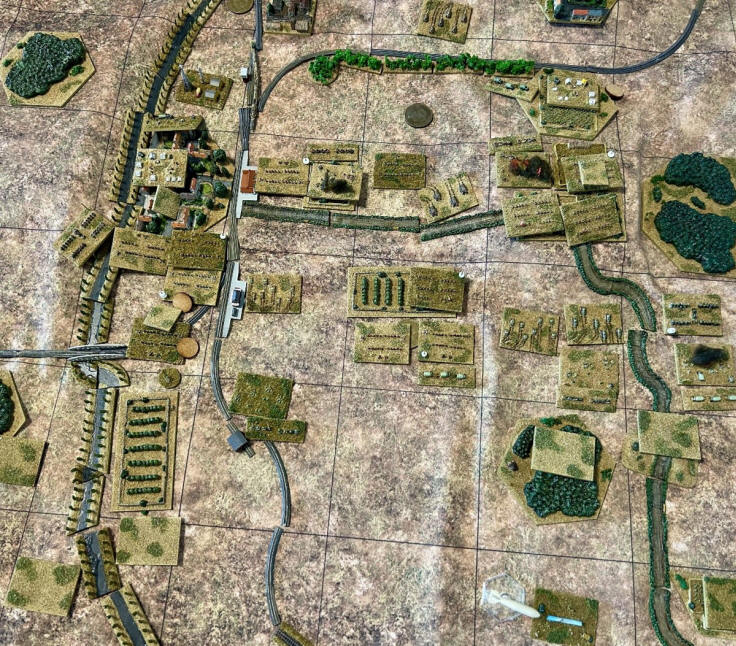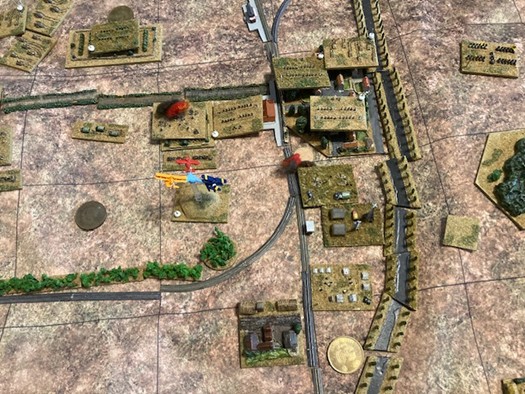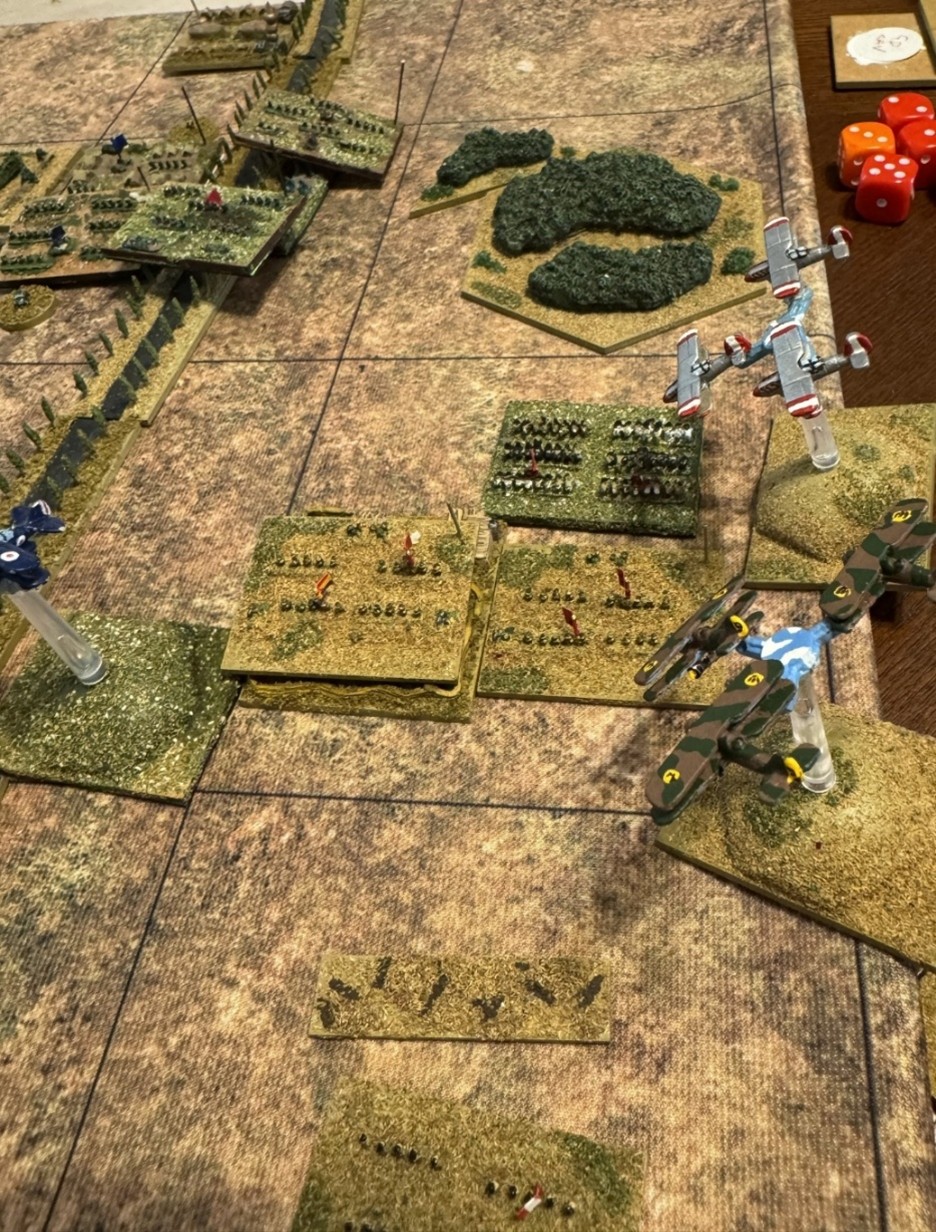|
|
|||||||||
|
|
Eisenhower Meets
Imaginations
By Hercule Poirot[1]
Well, Sam Mustafa has done it again – produced another excellent and
innovative set of rules.
Well, I have done it again – taken a perfectly good and simple set of
rules and added complications and changes to suit my own particular
tastes. Specifically, for my old “imaginations”
campaign set in 1930s Mitteleuropa where the nations from the Marx
Brothers’ “Duck Soup” (Freedonia and Sylvania,) Charlie Chaplin’s “The
Great Dictator” (Tomainia, Bacteria and Osterlich,) Hayao Miyazaki’s
“Porco Rosso” (The Free State of Fiume,) Biggles (Maltova and Lovitzna,)
Orwell (Oceanea and Eurasia,) Dilbert (Elbonia,) and of course, the
grandaddy of all imaginations, Ruritania, all battle it out for
supremacy in “Danubia.”
Eisenhower is the latest game from Sam Mustafa.
This time he handles
multi-divisional sized battles in Europe in World War II. The details
are here:
https://sammustafa.com/eisenhower
And two how to play vids are here:
https://www.youtube.com/watch?v=iJyhOBNX2iU&t=1s
https://www.youtube.com/watch?v=XZipc07ZIe0&t=26s
Like all of Sam Mustafa’s rules, Eisenhower is ruthlessly stripped down,
with only three basic troop types: tanks, leg infantry and motorised
infantry. (Although advance rules and traits do add more unit types and
variations in troop quality.) Artillery and airpower are abstracted out
to cards and dice. I wanted to see if it could be made compatible with
the troops that we have for Danubia, everything from Landwehr to
armoured trains, with aircraft and artillery included. (Why you ask?
Because we have the toys and I damn well want to use them – that’s why!
But restoring artillery units removes an over-simplification in the
Eisenhower rules that your artillery is always where you want it, when
you want it.) This involved grafting the nuance and granularity of the
rules that we used for the Danubia battles, “The War To End All Wars”
(TWTEAW,) onto the simpler Eisenhower systems, to see if both sets still
worked. The result is Napalini.
The man himself: Benzino Napalini, (or, sometimes Napoloni,) Duce of
Bacteria, Presidente e Maresciallo di Campo, Grande ammiraglio della
flotta, Dictator, Statesman, Impresario, Activist and Influencer,
Chairman of the Bacterian Geographical and Exploration Society, Poet
Laureate, Jurist and Chairman of the Judicial Appointments Committee,
Patron of the Arts, visionary, preux chevalier, Gentiluomo, Man of
Destiny, fashion guru, Scientician, amateur yachtsman, manufacturer of
rain gauges and bespoke canal locks to the gentry, and Snowman. (Photo:
United Artists.)
Eisenhower is designed for a 6’ x 4’ table with 6” grids for 15-20mm
figures for up to six divisions. (So, 12 x 8 squares.) In Danubia’s
smaller world I used a Big Red Bat mat with a 4” grid for our 2mm toys,
with two divisions (Danubian “armies”) each, on a 24” x 32” table, (so,
6 x 8 squares,) to fit my dining table. The grids are not obtrusive to
look at, and they remove the need to measure movement and ranges so
speed everything up greatly. I had worried that they would impose a
rectangular look on the terrain, but this was not the case as the
squares were big enough to accommodate any curve or angle. There would
be no problem enlarging the Danubia table size for battles with more
divisions.
In Eisenhower rules as written, (RAW,) everything is deployed in plain
sight, so the players have a god-like view and full knowledge. I just
grafted the hidden unit deployments and dummies from TWTEAW onto the
system. Yes, it takes longer to set up this way, but the added
uncertainty and removing the helicopter view makes it well worth it.
Before the onslaught: The table with most units still hidden. The
Bacterians are on the right. The 50 cent coins are the three initial
objectives. I intend to replace these with spiffy flags of all the
waring nations.
So far, I have had two games testing the amalgam of rules. In the first
game Bill’s Bacteria took on Freedonia led by me. Bill chose to attack
so had a 25% strength point advantage, as per the Eisenhower set up.
Although 25% didn’t sound like much of an advantage to me it worked
well. The OBs were taken from the Danubia campaign, so they were not
symmetrical. The Bacterians brought overwhelming airpower with them.
Porco Rosso and the Dalmatia Sky Pirates take on Freedonian Gladiators.
The Gladiators' days are numbered - there are three more Bacterian
fighter wings where Porco came from.
Eisenhower entails the use of an A4 sized off-table “SHAFE” command post
for each player to faff about managing dice and cards. But Danubia
already has on table HQs, artillery units and aircraft, so with the
addition of little markers for “operations” and “stockpiles”, and cotton
wool smoke to show which artillery had fired, all the extraneous
paperwork can be dispensed with, and the focus returns to the table, not
the off-table SHAFE. The only thing that needed recording was the
accumulation of victory points.
In Eisenhower players alternate in allocating “operations,” (initiatives
for a division to move and fight,) in a three square by three square
grid. In the original rules you determine how many operations you have
for a given turn by first throwing dice and then allocating them for use
with certainty. Napalini flips this a bit – you allocate the ops, but
don’t dice to see if you can actually execute them until you try to use
them. The chance of losing an operation is the same in both sets, but
Napalini can derail a perfect plan. To partially ameliorate this, I have
grafted the “HQ Prompt” rule from TWTEAW into Napalini. This gives you a
limited number of options for the general and his HQ, (you,) to pay
particular attention to. One of these options is to increase the chance
of getting an operation, all well and good, but other options include
coordinating barrages and airstrikes, using stockpiles, sorting out
engineering tasks, and more good stuff that you might want to do. You
are unlikely to have enough prompts to do everything that you want...
decisions, decisions. All divisions have a minimum of one operation per
turn, and a maximum of three.
The Bacterian offensive in full swing.
Air power in Eisenhower is a zero-sum game. A card driven system, with
either one side having it all, or the other having it all, or neither
side having it. Air power in TWTEAW was the opposite, a
game-within-a-game with detailed movement and combat, that was fun, very
pretty, and had lots of Dakka, Dakka, Dakkaring; but was time consuming
and was quite often irrelevant. Napalini seems to split the difference
nicely. Fighters vie for air superiority in one dogfight and the
resulting balance of air power determines the chance of observation and
ground attack aircraft penetrating to their targets. I was afraid that
given the Bacterian four-to-one superiority in fighters we wouldn’t get
a good test of the rules. I was wrong. Yes, the outnumbered Freedonian
Gladiators did not last long, but late in the battle some plucky
Freedonian DH4s overcame overcast weather and Bacterian fighters to
strut their stuff. So, although your odds will vary, nothing is a
foregone conclusion. “Overcast” is another bit of added granularity in
Napalini. In Eisenhower weather is either good, or bad with no flying
and restricted ground movement. In Napalini overcast does not affect
ground troops and reduces, but does not eliminate, air effectiveness.
Against the odds: Breaking through the clouds, and the Bacterian
fighters, Freedonian DH4s put warheads on the foreheads of the Bacterian
artillery and cavalry below.
Played with divisional operations alternating from side to side, the
game has a good interactive feel. The defender can always “pass,” the
attacker cannot. Because there is a stacking limit of three combat
battalions in a square the system pushes you to think in terms of
brigades without having to keep track of actual organizations. I liked
this feeling. I saw myself deploying defending brigades, having reserves
in brigades, and counterattacking in brigades, all without having to
keep track of any brigades. We deployed 14 different ground troop types
instead of the three basic types in Eisenhower. It had occurred to me
that this diversity might clutter the system but really it was not a
problem. After all, you only have to remember whether your unit moves
one or two squares and throws one, two, or three dice in combat. That is
not difficult.
Eisenhower has a very clever “Objective” system that gives you a good
reason to fight for a location, but not an overwhelming incentive to die
unnecessarily when attacking or defending that location.
This keeps the game focussed and tense, and allows for the
strategic initiative, in terms of who has ‘the momentum” and can take
the first operation, to change. The game plays quickly. We got through
four turns – the length of a standard Eisenhower game - in the time it
took to play one Noel Coward and one Marlene Dietrich LP… musical
atmosphere has always been important in Danubia.
Bill proved that you can take the boy out of the Pennines, but you
cannot take the weather out of the boy, and for much of the battle he
managed to get overcast with a good West Yorkshire clag that reduced the
amount of ground-pounding my chaps had to suffer. Despite the narrow
front it was a very fluid battle with attack, counterattack, and
counter-counterattack. Combat is attritional so you can take a square
but find yourself so weakened that a well organised counterattack will
do for you, and this happened several times to both sides, so there is
lots of tension. Nighttime and card play allows you to rebuild and
reorganize. I thought that I was winning until the last couple of
initiatives of the last turn when my armoured counterattack that had
been going great guns suddenly wasn’t going any guns at all.
The End is Nigh! On the right the Bacterians have retaken the town. On
the left the Freedonians have re-taken the first objective in the centre
and it looks like their armour, top left, will sweep all before them...
they won't!
Il Duce had written another glorious page in Bacteria’s martial history.
For the second game Jeff’s Ruritania took on Freedonia and their
Osterlich allies commanded by Tony this time. Again, the attacking
Ruritanians had a 25% points advantage.
The Usual Suspects – Danubian veterans all.
From left to right: General James Custer-Dump; King Rudolf VII of
Ruritania; and Hercule Poirot.
For this game the hidden deployment came into its own. I use counters of
the right “footprint” with the unit identity or its dummy status written
on the underside so you can quickly swap them for the real units when
the visibility rules determine. This of course gives full play to use
aerial and ground reconnaissance, but King Rudolf didn’t get where he is
today by mindlessly heeding military college platitudes like: “Time
Spent in Reconnaissance is Seldom Wasted….” So, Jeff hammered straight
in and put his schwerpunkt on his right, hoping to roll into the two
objectives behind the Freedonian lines, but unbeknownst to him Tony had
already selected this area of woods and gentle hills as the perfect area
to conceal his best units for an intended thrust into the Ruritanian
rear, (ouch!)
The battlefield: This aerial photograph flattens out the hills which are
in the 3-4 o’clock and 10-11 o’clock positions. Ruritania is attacking
and will deploy in the bottom two rows. Napalini uses many more terrain
types than Eisenhower. In the RAW only the two towns at 2 o’clock and 9
o’clock, the two villages, (classified as “bocage” in Eisenhower,) at 6
o’clock and 11 o’clock, and the two woods at 1 o’clock and 7 o’clock,
would have appeared on the battlefield. The other roads, railways,
tracks, gentle hills, open woods and treelines, groves and farms would
have disappeared as “flat” terrain. The additional Napalini terrain adds
much more tactical nuance, and, just as importantly, looks nicer.
The two sides were evenly matched in the air, even down to both using
the same make of fighters. The weather was good, so planes had no
problem finding their targets. The Freedonians edged air superiority on
the first day, (which in Danubia consists of two turns compared to only
one turn in Eisenhower,) but the Ruritanian groundcrew equivalents of
Biggles’s Flight Sergeant Smyth did sterling work patching their crates
up overnight and they turned the tide on the second day.
Gladiatorial Combat Freedonian Gladiators and Ruritanian Gladiators vie for air supremacy. Clearly one of the big winners in the Danubian Wars is the Gloster Aircraft Compamy.
Having unknowingly picked the toughest part of the Freedonian line to
begin their initial assault, the surprised Ruritanians were handily
repulsed. King Rudolf then called up his airpower to attempt to bomb
their way through, but although the strikes easily found their targets,
they bombed abysmally. Now was the time for Custer-Dump to launch a
spirited Freedonian counterattack.
The key to the Eisenhower system is the interplay between alternating
operations by formations of both sides If your preference is for an
IGOUGO game where you move and fight everything with flawless precision,
and then your opponent does the same, then Eisenhower is not for you,
and Napalini even less so since I have made the allocation of operations
a tad more uncertain. In addition to this back-and-forth by-play the
number of operations allocated to formations, (and the number allocated
by your opponent to the enemy formations facing yours,) has a big
impact. Every formation must have at least one operation allocated to
it, but the real question is how do you allocate your remaining
operations? Do you go for an even split or do you favour one formation
over others? If two opposing formations have only one operation each you
can expect a slow skirmish. If both have multiple operations, then you
can expect a slugfest. But if a formation has several more operations
than its opponent you have the chance to pile on the pressure with
multiple movement and combat options. It was these dynamics that
dominated the game. Tony favoured his left flank counterattack, whilst
Jeff adopted a more balanced approach.
On the Ruritanian left flank two battalions of the International
Regiment[2]
and a regiment of cavalry are about to make life unpleasant for a lonely
battalion of Osterlich Landwehr at the very bottom of the picture.
Airstrikes by Osterlichian Fairey Foxes, and Freedonian DH4s will hurt
the attackers but not save the Landwehr. Meanwhile Ruritanian forces
mass on the highway to assault the town.
On the Ruritanian right flank the Freedonians made steady progress. By
nightfall they had pushed the Ruritanians back six miles, right to their
baseline, although with both sides grievously damaged. On the Ruritanian
left a well-orchestrated assault on the town stalled when the operations
dice didn’t oblige. But this proved to be a blessing in disguise, as
instead of just using their advantage in operations for a stand-up, and
no doubt mutually bloody, fight through the rubble of a built up area,
the Ruritanians used their advantage in operations to by-pass the first
town (which was not a victory objective,)
seize the objectives beyond it (which included the second town,)
pick off the Freedonian reserves, and overrun a Freedonian HQ.
Nighttime is logistics time in Eisenhower, when both sides use
“stockpiles” to rally exhausted units, and restore badly damaged units.
In a normal Eisenhower game the attacker has four stockpiles and the
defender two. This considerably ekes out the attacker’s only 25%
advantage in points, all the more so since the Freedonians had to
rebuild their lost non-combatant HQ, whereas the Ruritanians could focus
on restoring more combatant units. This disparity in logistics did not
bother me. The Eisenhower game system is designed to provide equal but
asymmetrical opportunity between the attacker and defender, not an
identical same number of points set-up that you get in most other game
systems. The attacker must attack to take the victory objectives and 25%
more hardware and twice the logistics by no means makes this easy.
In any event I intend to use
these rules in my campaign, where strengths in men, materiel and
logistics will be determined by the overall strategic situations, not by
concepts of balance and fairness. And, in fairness to the original
design, in much bigger Eisenhower games, the difference between two and
four stockpiles, would not be as significant as in smaller Napalini
games.
Thus, the sun rose over a relatively much stronger Ruritanian army, and,
still holding the momentum because they held the objectives, the
Ruritanians moved first and quickly to put the final pressure on the
Freedonians. A plucky Freedonian counterattack gave up the first town to
temporarily re-take the second, but this just left the Freedonians
depleted and out of their prepared positions…. By noon it was all over,
and King Rudolf was knighting his commanders on the battlefield.
Although pushed back to their own baseline the relatively stronger
Ruritanian tanks and artillery hit the Freedonians in the flank at dawn.
The little circular jeep marker is used instead of an unsightly dice to
mark the centre of operations, activating the units in the adjacent
squares.
I had a good feeling when I first read Eisenhower, and, having played
it, I have an even better feeling. The basic system is very bland, but
that is an advantage because I think that you can add nuance and
granularity to taste, without breaking the core system and overloading
its simplicity. Danubia has its own requirements, and I appreciate that
you may not have a hankering to include the armoured trains and river
gunboats that I love so much, but you could easily tinker with any 20th
Century historical period and add bells and whistles until you have the
level of period flavour that you prefer. For example, you could have a
simple matrix showing type of tank defending against type of gun
attacking with the result being either a +1, or -1, or = on your dice
throw; or you can add unit types or terrain effects to taste. I am now inspired to finish Napalini, the rules attached here are still a work in progress, about 85% complete and are still needing a few tweaks. After that, who knows what might happen in Danubia . . .
[1]
Really, it’s by
Peter Hunt. But to run
my 1930s Danubia campaign I stole the great concept of “Warfare
in the Age of Poirot” from this chap:
https://jozistinman.blogspot.com/2019/01/ruritanian-elbonian-war-of-1925-battle-1.html
[2]
Idealists from Britain and France who come to Danubia not: “…
[for] Glory, revenge, or pay: /We came because our open eyes/
Could see no other way.”
(C. Day-Lewis, “The Volunteer.”)
|

